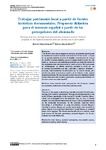Mostrar o rexistro simple do ítem
Trabajar patrimonio local a partir de fuentes históricas documentales. Propuesta didáctica para el noroeste español a partir de las percepciones del alumnado
| dc.contributor.author | Suárez Álvarez, Patricia | |
| dc.contributor.author | García-Morís, Roberto | |
| dc.date.accessioned | 2024-08-16T11:02:23Z | |
| dc.date.available | 2024-08-16T11:02:23Z | |
| dc.date.issued | 2023 | |
| dc.identifier.citation | Suárez Álvarez, P., & García-Morís, R. (2023). Trabajar patrimonio local a partir de fuentes históricas documentales. Propuesta didáctica para el noroeste español a partir de las percepciones del alumnado. Maskana, 14(2), 9-17. https://doi.org/10.18537/MSKN.14.02.01 | es_ES |
| dc.identifier.issn | 1390-6143 | |
| dc.identifier.issn | 2477-8893 | |
| dc.identifier.uri | http://hdl.handle.net/2183/38604 | |
| dc.description.abstract | [Resumen] Tras llevar a cabo una investigación histórica, se presenta una propuesta de trasferencia desde la historia local hacia la historia escolar. A través de un ejemplo aplicado al norte de España, concretamente al concejo de Carreño (Asturias, España), que se investigó desde el punto de vista histórico, se propuso una trasferencia didáctica que parte del estudio de las representaciones escolares sobre el medio próximo. En la propuesta se problematizan los saberes históricos escolares a través del uso de fuentes documentales que dan visibilidad a espacios, temáticas y personas, tradicionalmente invisibilizados por la historia escolar, pero que forman parte de la historia social o de la historia de las mujeres desde hace décadas. El caso escogido nos ha permitido identificar fuentes locales útiles para este cometido, generando una propuesta alineada con el nuevo marco curricular español. | es_ES |
| dc.description.abstract | [Abstract] The aim of this paper is describing a transfer proposal of local history starting from students’ perceptions. Through an example applied to the north of Spain, specifically to the council of Carreño (Asturias, Spain), which was investigated from the historical point of view, a didactic transfer was proposed that starts from the study of school representations on the immediate environment. In the proposal, historical school knowledge is problematized by using documentary sources that give visibility to spaces, themes and people, traditionally made invisible by school history, but which have been part of social history or women’s history for a long time. The chosen case has allowed us to identify useful local sources for this task, generating a proposal aligned with the new Spanish curricular framework. | es_ES |
| dc.language.iso | spa | es_ES |
| dc.publisher | Universidad de Cuenca | es_ES |
| dc.relation.uri | https://doi.org/10.18537/mskn.14.02.01 | es_ES |
| dc.rights | Atribución-NoComercial-CompartirIgual 3.0 España | es_ES |
| dc.rights.uri | http://creativecommons.org/licenses/by-nc-sa/3.0/es/ | * |
| dc.subject | historia local | es_ES |
| dc.subject | percepciones del alumnado | es_ES |
| dc.subject | fuentes documentales | es_ES |
| dc.subject | didáctica de la historia | es_ES |
| dc.subject | historia escolar | es_ES |
| dc.subject | local history | es_ES |
| dc.subject | students’ perceptions | es_ES |
| dc.subject | documental sources | es_ES |
| dc.subject | didactics of history | es_ES |
| dc.subject | school history | es_ES |
| dc.title | Trabajar patrimonio local a partir de fuentes históricas documentales. Propuesta didáctica para el noroeste español a partir de las percepciones del alumnado | es_ES |
| dc.title.alternative | Working with local heritage from documentary historical sources. Didactic proposal for the Spanish northwest from the perceptions of the students. | es_ES |
| dc.type | info:eu-repo/semantics/article | es_ES |
| dc.rights.access | info:eu-repo/semantics/openAccess | es_ES |
| UDC.journalTitle | Maskana | es_ES |
| UDC.volume | 14 | es_ES |
| UDC.issue | 2 | es_ES |
| UDC.startPage | 9 | es_ES |
| UDC.endPage | 17 | es_ES |
| dc.identifier.doi | 10.18537/MSKN.14.02.01 |






